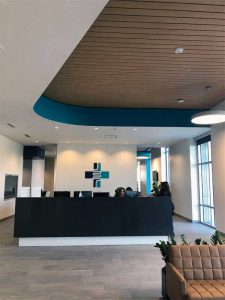
Red and yellow indicate a lot of noise is reflected off the ceiling. The consistent red areas are loud noise reflecting off the hard, painted metal, light fixtures, and supply air diffusers.
Blue indicates very little or no noise is reflected off the ceiling. In other words, the ceiling is absorbing the noise, as it should. The open return air grille on the right of Figure 1 is always blue because the sound passes through the ceiling into the plenum above, indicating ideal absorption.
A ceiling becomes highly absorptive when panels have an NRC 0.90 because they are entirely blue at that level of absorption.
Standards, guidelines, and building rating systems
In addition to evidence-based design principles, there are standards, guidelines, and building rating systems either requiring or recommending high-performing, sound-absorptive ceilings or other surfaces to control noise, improve recovery and satisfaction, and decrease costs (Figure 2).
The Facility Guidelines Institute (FGI) says all normally occupied hospital spaces shall incorporate acoustically absorptive surfaces such as ceilings (section 1.2-6.1.3).
Green Globes (the American National Standards Institute and Green Building Initiative [ANSI/GBI] 01-2019, Green Globes Assessment Protocol for Commercial Buildings) requires sound-absorptive ceilings of NRC 0.90 or higher inside patient and resident care areas, medication safety zones, and exam and treatment rooms (section 11.5.4.1.3).
High-performing, sound-absorptive ceilings of NRC 0.90 absorb a lot of noise, allowing patients to get quality restorative sleep. They can recover faster with fewer complications and readmissions. This not only drives down cost, but also leads to better outcomes for patients and healthcare facilities.
How high-performing ceilings impact infection control
Building material surfaces, including ceiling panels, play a role in controlling the spread of bacteria and infection. To create a safe environment:
- these materials should not provide nourishment for potentially harmful microorganisms;
- their surfaces should be easy to clean and disinfect without affecting their appearance or performance; and
- the ceiling panels also should be durable and demountable to accommodate any necessary maintenance in the plenum.
Clean materials, clean air
Minimizing maintenance time and costs, high-quality ceiling panels are manufactured for durability. If needed, these products can be vacuum-cleaned with a soft brush attachment. Where infection control is the priority, specially treated medical and hygienic ceiling panel finishes allow cleaning with water and some diluted disinfectants. In some cases, special finishes allow for more intensive cleaning.
Some building manufacturers add biocides to enhance the antimicrobial performance of their products in areas with high humidity or healthcare facilities. As with overuse of antibiotics, the overuse of antimicrobials could give rise to resistant bacteria, which may have a negative impact on health. A better solution is to specify products that do not use antimicrobial additives to increase the product’s resistance.
People with compromised immune systems, including patients in healthcare buildings, children and infants in pediatric care, and the elderly residents of long-term care facilities, are often susceptible to pollutants emitted from materials. This makes the need to improve indoor air quality (IAQ) critical. Not only are patients and residents at risk; high levels of pollutants and contaminants can lead to loss of concentration, and irritation for staff, caregivers, and visitors alike.




